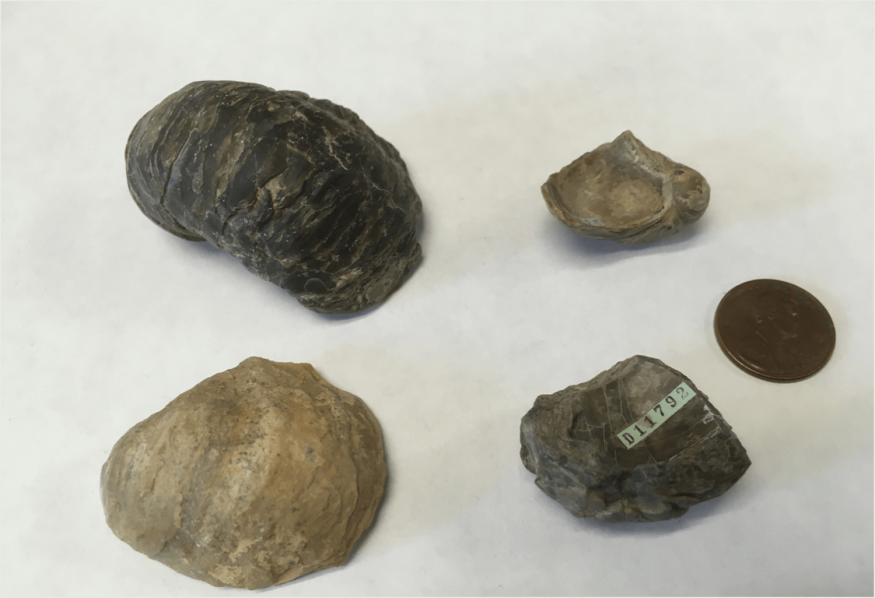
A new University of Michigan study that used fossil oyster shells as paleothermometers found the shallow sea that covered much of western North America 95 million years ago was as warm as today's tropics.
The study provides the first direct temperature data from that vast mid-latitude sea during the height of the Cretaceous Thermal Maximum, one of the planet's hottest climate intervals of the past several hundred million years.
The findings, published online May 9 in the journal Geology, also hint at what may be in store for future generations unless emissions of heat-trapping greenhouse gases are reined in.
"These data indicate that the North American interior during the peak of the Cretaceous greenhouse was as warm as the hottest conditions in the modern-day tropics-imagine the climate of Bali, Indonesia, in places like Utah or Wyoming," said study lead author Matt Jones, a former University of Michigan postdoctoral researcher now at the Smithsonian Institution's National Museum of Natural History.
The study found that average water temperatures in the Western Interior Seaway during the mid-Cretaceous ranged from 28 to 34 degrees Celsius (82 F to 93 F), as warm as modern tropical extremes like the Indo-Pacific Warm Pool, which consistently exhibits the highest water temperatures over the largest expanse on the Earth's surface.
Atmospheric carbon dioxide concentrations in the mid-Cretaceous are still a topic of debate among researchers, but many studies have shown levels in excess of 1,000 parts per million. Today's levels are a bit over 420 ppm but could surpass 1,000 by the end of this century unless fossil-fuel emissions are curtailed, according to climate scientists.
"These new findings help resolve temperatures in North America during a peak greenhouse warmth interval in the geologic past, which in turn may help us better predict just how warm Earth may be in the future under projected higher atmospheric CO2 conditions," said U-M geochemist and study co-author Sierra Petersen, an assistant professor in the Department of Earth and Environmental Sciences.
To determine just how hot North America was during the peak Cretaceous greenhouse world 95 million years ago, the researchers analyzed 29 well-preserved oyster shells from a U.S. Geological Survey fossil collection.
The fossils came from sandstone and shale outcrops in Wyoming, Colorado, Utah, New Mexico and Arizona-locations that were at a similar latitude as today but were underwater during the Cretaceous. At that time, the Western Interior Seaway stretched from the Gulf of Mexico to the Arctic and from present-day Utah to Iowa.
Fossils collected across the western interior of the U.S. show that the seaway teemed with marine life including massive clams, spiral-shelled ammonites and extinct types of oysters. Dinosaurs roamed the adjacent coastal plains.
For the current study, researchers used fossil oyster shells collected over several decades by Bill Cobban, one of the preeminent American paleontologists of the 20th century, and his colleagues. As the oysters grew, their shells incorporated various forms, or isotopes, of the elements oxygen and carbon, in ratios that reveal the temperature of the surrounding seawater.
With a small Dremel drill, Jones sampled the fossil shells and collected the powdered calcite. Using a state-of-the-art mass spectrometer in Petersen's U-M lab, the researchers measured the isotopic ratios of carbon and oxygen. Specifically, they looked at the occurrence of the heavy carbon isotope carbon-13 and the heavy oxygen isotope oxygen-18, and how often they were found bound together in the calcite crystal structure.
This frequency of bonding of the two heavy isotopes, called isotopic clumping, is highly sensitive to the ambient temperature when a mineral is formed, permitting scientists to reconstruct past temperatures through a recently developed technique called clumped isotope paleothermometry.
"Many generations of geologists have studied the paleontology and stratigraphy of the Western Interior Seaway, providing different ideas about past climate and a foundation of knowledge that made this study possible," Jones said. "However, no direct paleothermometer measurements existed-until now-from the interior of North America for the peak of this Cretaceous greenhouse world.
"This paucity of records has hindered solid understanding of the temperature evolution of North America through the Cretaceous and the influence of temperature on the continent's marine biotas in the seaway, as well as on terrestrial fauna like the dinosaurs inhabiting the adjacent coastal plains."
North American data from the new study is consistent with previous studies that used traditional oxygen isotope paleothermometry techniques at open-ocean sites globally, according to the authors. Those earlier studies, which measured the ratio of stable isotopes of oxygen, inferred sea-surface temperatures in the high 20s C (low 80s F) from the sub-Antarctic to the mid-30s C (upper 90s F) from the tropics and southern mid-latitudes.
In addition to the specific findings quantifying past global warmth in the Western Interior Seaway, the new study also demonstrates how this particular geochemical technique can be used to reveal climate conditions in the deep past, where prior techniques have struggled.
"Even after working with the clumped isotope paleothermometer for 15 years, it's still amazing to me that, given the right samples, we can essentially dip a thermometer into a 95-million-year-old ocean and figure out how warm it was," Petersen said. "If we want to be able to better predict how different life on Earth may respond to future warming, concrete temperature estimates in past warm periods can help us set upper limits on survivability."
The other author of the Geology paper is U-M graduate student Allison Curley. The work was funded by the National Science Foundation, the University of Michigan and the Peter Buck Fellowship at the National Museum of Natural History.
Study: A tropically hot mid-Cretaceous North American Western Interior Seaway
© 2025 NatureWorldNews.com All rights reserved. Do not reproduce without permission.





